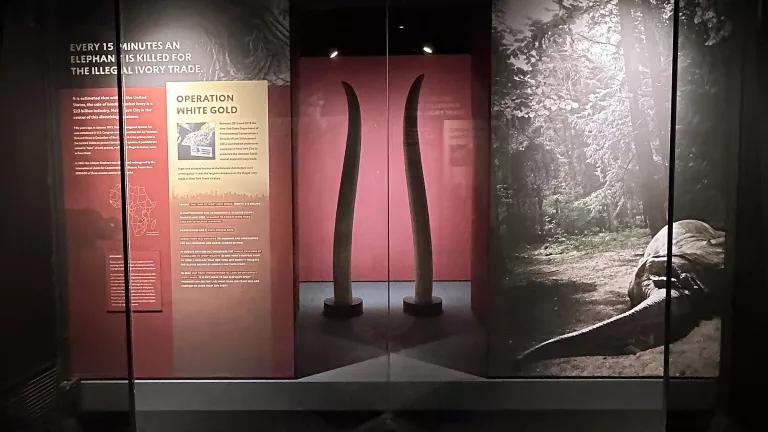New York City Remains a Battleground for Illegal Ivory Trade
The New York State Department of Environmental Conservation announces new exhibit of confiscated ivory at the New York State Museum that educates the public about the harmful industry.

Millions of dollars' worth of elephant ivory is now on display at the New York State Museum in Albany, New York.
The New York State Department of Environmental Conservation (DEC) recently announced that some of the elephant ivory seized during a 2015–2018 undercover operation called "Operation White Gold” is now on display at the New York State Museum. The exhibit demonstrates the decades-long crisis that threatens the existence of these animals and provides a chronology of the DEC’s major enforcement action against sales of illegal ivory products. The exhibit aims to inspire people to act and join in the fight to protect endangered species and to stop the illegal sale and trade of ivory, which unfortunately continues to this day, especially in New York City’s antiques industry.
Focusing on high-end antiques dealers and wholesale distributors, Operation White Gold resulted in the largest-ever crackdown on illegal ivory trade in state history, with approximately 40 corporations and 75 individuals being charged with felony-level crimes. The state agency utilized multiple enforcement tactics, like storefront inspections and undercover purchases. Nearly two tons of ivory, worth more than $12 million, were seized during the operation. Most of the confiscated ivory was destroyed in 2017 to permanently remove it from circulation and resale, while the rest is now in the museum.
Operation White Gold emerged from a 2014 state bill to ban the sale of elephant and mammoth ivory as well as rhino horn. At the time, this was the strongest ivory ban in the United States, and it strengthened an existing state law that had only treated illegal wildlife transfers as a minor offense. The bill imposed more significant penalties and fines for attempted sales of illegal ivory worth more than $25,000. Though 82 percent of New Yorkers supported the bill, it met strong resistance from New York City auction houses like Christie’s, which submitted memos claiming that the proposed legislation would shut down “the legitimate market in antique objects containing them, essentially rendering their potentially valuable collections worthless."
However, this is the economic framework that has buttressed the slaughter of elephants and rhinos for centuries. Established art and luxury auction houses ascribe market value to ivory that typically drives up its price, maintaining the monetary incentives for poachers to continue hunting elephants into extinction. In turn, what is sold at Christie's or Sotheby’s provokes further consumer demand, building and complementing a retail market served by antiques stores. There were other opponents of the bill as well, including the National Rifle Association, whose opposition was a defense of the industry’s use of ivory handgun grips. This highlighted, inadvertently, the far-reaching financial ties of the poaching industry.
The most egregious case of wrongdoing regarding illegal ivory was discovered by a student at Columbia University named Wendy Hapgood. She found that the Metropolitan Fine Arts & Antiques store in Manhattan was attempting to sell recently poached elephant ivory by passing it off as mammoth ivory. Responding to Hapgood’s tip, two DEC undercover investigators posed as buyers to purchase a statue allegedly made of mammoth tusk. The DEC tested the tusk at the American Museum of Natural History and found it to be African elephant ivory. The DEC issued a search warrant and found more than 1,600 pieces of ivory worth more than $4.5 million. Two antiques traders, Irving and Samuel Morano, and salesman Victor Zilberman were indicted, which resulted in them forfeiting all ivory items, giving $200,000 to wildlife conservation groups, and paying $2,000 to the DEC.
New York State’s ivory ban will continue to smother the state’s illegal ivory market by targeting imported goods and by coordinating with organizations working on the frontlines to halt poaching. The DEC sees this as a global fight as the agency has deployed a team of investigators to create a training program in Africa that works with governments and NGOs to fight the organized forces responsible for the destruction of elephant and rhino populations. But to continue to fight ivory sales at the retail level and at the start of the supply chain, the DEC needs adequate resources.
New York State will soon begin budget negotiations. It’s essential that the DEC be adequately funded and staffed to help save the lives of the dwindling elephant and rhino populations. Without the DEC’s aggressive enforcement, poachers, traders, and antiquers will continue to reap exorbitant profits from the killing of these animals.




